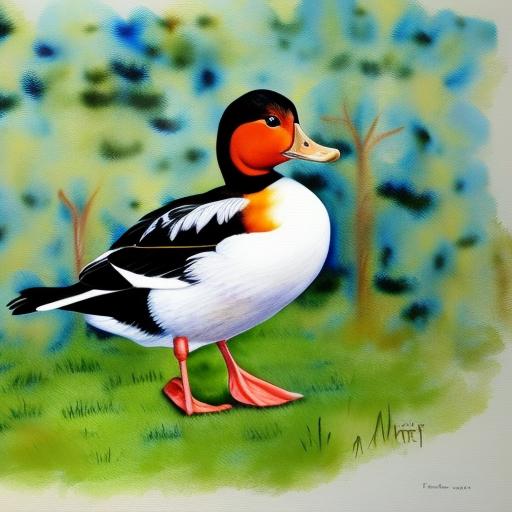The American Poultry Association (APA) recognizes and sets standards for various breeds of ducks, ensuring that they meet specific criteria for size, color, and other physical attributes. These standards are used in poultry shows and exhibitions to judge the quality of the ducks. APA duck breeds are popular among breeders and enthusiasts for their unique characteristics and versatility. They are raised for various purposes, including meat, eggs, and ornamental display. The APA has played a significant role in preserving and promoting these duck breeds, ensuring their continued existence and popularity among poultry enthusiasts.
Key Takeaways
- APA duck breeds are recognized by the American Poultry Association for their unique characteristics and qualities.
- The history and origin of APA duck breeds can be traced back to various regions and countries around the world.
- APA duck breeds are known for their distinct physical attributes, including size, color, and feather patterns.
- Some popular APA duck breeds include the Pekin, Rouen, and Indian Runner, each with its own unique traits and qualities.
- APA duck breeds are used for various purposes, including egg production, meat, and ornamental purposes, making them versatile and valuable to farmers and breeders.
History and Origin of APA Duck Breeds
The history of APA duck breeds dates back to the 19th century when the American Poultry Association was established to promote and standardize poultry breeds in the United States. The association recognized various duck breeds based on their unique characteristics and utility. Many of these breeds have a rich history, with some originating from Europe and Asia and being brought to the United States by early settlers. Over time, these duck breeds were selectively bred for specific traits, leading to the development of distinct varieties that are recognized by the APA today. The association has played a crucial role in documenting the history and origin of these duck breeds, ensuring that their heritage is preserved for future generations.
Characteristics and Physical Attributes of APA Duck Breeds
APA duck breeds are known for their diverse characteristics and physical attributes, making them popular among poultry enthusiasts. These breeds come in various sizes, colors, and plumage patterns, each with its unique charm and appeal. Some breeds are known for their excellent egg-laying abilities, while others are prized for their flavorful meat. Additionally, many APA duck breeds exhibit distinctive behaviors and temperaments, making them suitable for different purposes and environments. The association has set specific standards for each breed, outlining the ideal characteristics and physical attributes that judges look for in poultry shows and exhibitions.
APA duck breeds are also known for their adaptability to different climates and environments, making them suitable for various regions across the United States. Whether it’s the cold winters of the northern states or the hot summers of the southern states, these duck breeds have proven to be resilient and hardy. Their ability to thrive in diverse conditions has contributed to their popularity among breeders and farmers looking for versatile and low-maintenance poultry options.
Popular APA Duck Breeds
Some of the most popular APA duck breeds include the Pekin, Rouen, Khaki Campbell, Indian Runner, and Welsh Harlequin. Each of these breeds has its unique characteristics and qualities that make them desirable for different purposes. The Pekin duck is known for its large size and excellent meat production, making it a popular choice for commercial farming. The Rouen duck, with its striking plumage and calm demeanor, is often raised for ornamental purposes and exhibition. The Khaki Campbell is prized for its exceptional egg-laying abilities, making it a favorite among backyard poultry keepers.
The Indian Runner duck is known for its upright posture and distinctive walking style, while the Welsh Harlequin is valued for its beautiful coloration and gentle nature. These popular APA duck breeds have gained recognition for their versatility and utility, appealing to a wide range of poultry enthusiasts with different interests and preferences. Whether it’s for meat production, egg-laying, or ornamental display, these breeds offer something for everyone.
Uses and Purposes of APA Duck Breeds
APA duck breeds are utilized for various purposes, including meat production, egg-laying, ornamental display, and conservation efforts. The Pekin duck, with its large size and rapid growth rate, is commonly raised for meat production in commercial farming operations. Its flavorful meat and efficient feed conversion make it a popular choice among producers looking for a profitable venture. The Khaki Campbell, on the other hand, is prized for its exceptional egg-laying abilities, often outperforming many chicken breeds in terms of egg production. This makes it a valuable asset for small-scale farmers and homesteaders looking to supplement their household food supply.
In addition to their practical uses, APA duck breeds are also raised for ornamental display in backyard settings and poultry exhibitions. Their diverse colors, patterns, and unique physical attributes make them a delightful addition to any farm or homestead. Many enthusiasts enjoy showcasing their ducks at local fairs and exhibitions, where they can compete for awards based on the APA standards. Furthermore, these duck breeds play a crucial role in conservation efforts aimed at preserving rare and endangered varieties. By raising and breeding these ducks, enthusiasts contribute to the conservation of genetic diversity within the poultry industry.
Care and Maintenance of APA Duck Breeds

Proper care and maintenance are essential for ensuring the health and well-being of APA duck breeds. Providing a suitable living environment with access to clean water, nutritious feed, and adequate shelter is crucial for their overall welfare. Ducks require access to water for swimming and bathing, as well as foraging opportunities to exhibit natural behaviors. It’s important to provide a balanced diet that meets their nutritional needs, including protein-rich feeds for growing ducks and laying rations for egg-producing breeds.
Regular health checks and preventive measures are necessary to safeguard against common poultry diseases and parasites. Vaccinations, deworming, and biosecurity protocols can help minimize the risk of illness and ensure a thriving flock. Proper housing with adequate ventilation and protection from predators is essential for creating a safe and comfortable environment for ducks. Additionally, maintaining cleanliness in the coop or housing area is crucial for preventing disease outbreaks and promoting good hygiene practices.
Conservation and Preservation Efforts for APA Duck Breeds
Conservation and preservation efforts play a vital role in safeguarding the genetic diversity of APA duck breeds. Many rare and heritage varieties are at risk of extinction due to declining population numbers and loss of genetic integrity. The APA has been actively involved in promoting conservation programs aimed at preserving these valuable duck breeds for future generations. Through education, outreach, and advocacy, the association raises awareness about the importance of maintaining genetic diversity within poultry populations.
Enthusiasts and breeders also play a crucial role in conservation efforts by raising rare and endangered APA duck breeds, contributing to the preservation of their unique genetic traits. By participating in breeding programs and promoting responsible stewardship of these breeds, individuals can make a meaningful impact on the conservation of poultry diversity. Furthermore, collaborative efforts with agricultural organizations, research institutions, and government agencies help support conservation initiatives aimed at protecting rare duck breeds from extinction.
In conclusion, APA duck breeds have a rich history and diverse characteristics that make them valuable assets to the poultry industry. From their origins in different parts of the world to their uses in meat production, egg-laying, ornamental display, and conservation efforts, these duck breeds have captured the interest of poultry enthusiasts worldwide. By understanding their unique qualities and promoting responsible stewardship, we can ensure the continued existence and popularity of APA duck breeds for generations to come.
If you’re interested in learning more about duck breeds, you might also want to check out this informative article on duck mating season. Understanding the mating season can be crucial for breeders and enthusiasts looking to raise ducks. It’s a great resource for anyone interested in the care and breeding of ducks.
FAQs
What are APA duck breeds?
APA duck breeds are duck breeds that are recognized by the American Poultry Association (APA) for their standard of perfection in terms of breed characteristics, conformation, and color.
How many duck breeds are recognized by the APA?
The APA recognizes over 20 different duck breeds, each with its own unique characteristics and qualities.
What are some examples of APA duck breeds?
Some examples of APA duck breeds include the Pekin, Rouen, Khaki Campbell, Indian Runner, and Welsh Harlequin.
What are the characteristics of APA duck breeds?
APA duck breeds are known for their distinct physical features, such as body shape, size, color, and feather patterns. They also have specific behavioral traits and are often bred for their egg production or meat quality.
Are APA duck breeds suitable for backyard or small-scale farming?
Yes, many APA duck breeds are well-suited for backyard or small-scale farming due to their adaptability, hardiness, and ability to forage for food. They can also be raised for eggs, meat, or as pets.
Where can I find more information about APA duck breeds?
You can find more information about APA duck breeds from the American Poultry Association’s official website, as well as from books, online resources, and local breeders or poultry associations.
Meet Walter, the feathered-friend fanatic of Florida! Nestled in the sunshine state, Walter struts through life with his feathered companions, clucking his way to happiness. With a coop that’s fancier than a five-star hotel, he’s the Don Juan of the chicken world. When he’s not teaching his hens to do the cha-cha, you’ll find him in a heated debate with his prized rooster, Sir Clucks-a-Lot. Walter’s poultry passion is no yolk; he’s the sunny-side-up guy you never knew you needed in your flock of friends!







